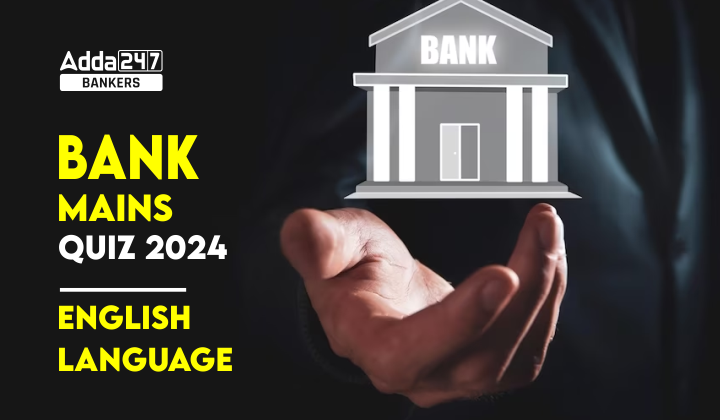Directions (1-5): In the following passage there are blanks, each of which has been numbered. These numbers are printed below the passage and against each, five phrases are suggested, one of which fits the blank appropriately. Find out the appropriate phrase in each case to make the sentence contextually meaningful and grammatically correct.
Q1. For some years now, the so-called JAM trinity (Jan Dhan-Aadhaar-Mobile) has been __________ (1) __________ infrastructure for India. The term “trinity” itself gives a sense of the faith and fervor this project sought to inspire. It was born in chapter 3 of the Economic Survey 2015, titled “Wiping every tear from every eye: The JAM number trinity solution”. This early JAM promo humbly concluded that “nirvana today seems within reach”. JAM’s virtues were praised again in the following year’s Economic Survey.
What JAM really means, in practical terms, is conveniently vague. The original formulation, in 2015, mentioned __________ (2) __________ mobile banking and post office payments. The second option never made much headway, perhaps because __________ (3) __________ for private profit. So Aadhaar-enabled mobile banking became the supreme goal. In 2017, NITI Aayog CEO Amitabh Kant predicted __________ (4) __________ other than mobiles: “… in the next two-and-a-half years, India will make all its debit cards, credit cards, all ATM machines all POS machines totally irrelevant… because every Indian will be doing his transaction just by using his thumb in thirty seconds …” This utopia was happily embraced by a familiar bandwagon of Aadhaar champions, fintech companies and embedded economists.
The intoxication reached new heights as __________ (5) __________ flourishing narrative— universal basic income (UBI). If you want to make cash transfers to everyone, what better platform can you have than Aadhaar, India’s unique biometric ID, doubling up as a financial address?
(a) consist of monthly transfers of Rs. 500
(b) JDY approached to fare poorly on several
(c) propounded as a dream cash-transfer
(d) the lead cash-relief measure in the national
(e) is far more transparent and well-organized
Q2. For some years now, the so-called JAM trinity (Jan Dhan-Aadhaar-Mobile) has been __________ (1) __________ infrastructure for India. The term “trinity” itself gives a sense of the faith and fervor this project sought to inspire. It was born in chapter 3 of the Economic Survey 2015, titled “Wiping every tear from every eye: The JAM number trinity solution”. This early JAM promo humbly concluded that “nirvana today seems within reach”. JAM’s virtues were praised again in the following year’s Economic Survey.
What JAM really means, in practical terms, is conveniently vague. The original formulation, in 2015, mentioned __________ (2) __________ mobile banking and post office payments. The second option never made much headway, perhaps because __________ (3) __________ for private profit. So Aadhaar-enabled mobile banking became the supreme goal. In 2017, NITI Aayog CEO Amitabh Kant predicted __________ (4) __________ other than mobiles: “… in the next two-and-a-half years, India will make all its debit cards, credit cards, all ATM machines all POS machines totally irrelevant… because every Indian will be doing his transaction just by using his thumb in thirty seconds …” This utopia was happily embraced by a familiar bandwagon of Aadhaar champions, fintech companies and embedded economists.
The intoxication reached new heights as __________ (5) __________ flourishing narrative— universal basic income (UBI). If you want to make cash transfers to everyone, what better platform can you have than Aadhaar, India’s unique biometric ID, doubling up as a financial address?
(a) two possible incarnations of the trinity
(b) shareholders opened accounts en masse to meet
(c) that the subsidies reach only to those who need them
(d) the changes lives and future of millions
(e) its major role in stopping corruption
Q3. For some years now, the so-called JAM trinity (Jan Dhan-Aadhaar-Mobile) has been __________ (1) __________ infrastructure for India. The term “trinity” itself gives a sense of the faith and fervor this project sought to inspire. It was born in chapter 3 of the Economic Survey 2015, titled “Wiping every tear from every eye: The JAM number trinity solution”. This early JAM promo humbly concluded that “nirvana today seems within reach”. JAM’s virtues were praised again in the following year’s Economic Survey.
What JAM really means, in practical terms, is conveniently vague. The original formulation, in 2015, mentioned __________ (2) __________ mobile banking and post office payments. The second option never made much headway, perhaps because __________ (3) __________ for private profit. So Aadhaar-enabled mobile banking became the supreme goal. In 2017, NITI Aayog CEO Amitabh Kant predicted __________ (4) __________ other than mobiles: “… in the next two-and-a-half years, India will make all its debit cards, credit cards, all ATM machines all POS machines totally irrelevant… because every Indian will be doing his transaction just by using his thumb in thirty seconds …” This utopia was happily embraced by a familiar bandwagon of Aadhaar champions, fintech companies and embedded economists.
The intoxication reached new heights as __________ (5) __________ flourishing narrative— universal basic income (UBI). If you want to make cash transfers to everyone, what better platform can you have than Aadhaar, India’s unique biometric ID, doubling up as a financial address?
(a) it needed databases of eligible individuals
(b) the constraint were significantly eased
(c) mobiles cannot only transfer money quickly
(d) it did not have enough scope
(e) it improved the quality of service delivery
Q4. For some years now, the so-called JAM trinity (Jan Dhan-Aadhaar-Mobile) has been __________ (1) __________ infrastructure for India. The term “trinity” itself gives a sense of the faith and fervor this project sought to inspire. It was born in chapter 3 of the Economic Survey 2015, titled “Wiping every tear from every eye: The JAM number trinity solution”. This early JAM promo humbly concluded that “nirvana today seems within reach”. JAM’s virtues were praised again in the following year’s Economic Survey.
What JAM really means, in practical terms, is conveniently vague. The original formulation, in 2015, mentioned __________ (2) __________ mobile banking and post office payments. The second option never made much headway, perhaps because __________ (3) __________ for private profit. So Aadhaar-enabled mobile banking became the supreme goal. In 2017, NITI Aayog CEO Amitabh Kant predicted __________ (4) __________ other than mobiles: “… in the next two-and-a-half years, India will make all its debit cards, credit cards, all ATM machines all POS machines totally irrelevant… because every Indian will be doing his transaction just by using his thumb in thirty seconds …” This utopia was happily embraced by a familiar bandwagon of Aadhaar champions, fintech companies and embedded economists.
The intoxication reached new heights as __________ (5) __________ flourishing narrative— universal basic income (UBI). If you want to make cash transfers to everyone, what better platform can you have than Aadhaar, India’s unique biometric ID, doubling up as a financial address?
(a) the total number of accounts in which the cash was transferred
(b) the imminent demise of all cash-transfer paraphernalia
(c) and provided the government with more fiscal bandwidth
(d) the prevention of leakage in the payment system
(e) an integrated approach to bring about comprehensive financial
Q5. For some years now, the so-called JAM trinity (Jan Dhan-Aadhaar-Mobile) has been __________ (1) __________ infrastructure for India. The term “trinity” itself gives a sense of the faith and fervor this project sought to inspire. It was born in chapter 3 of the Economic Survey 2015, titled “Wiping every tear from every eye: The JAM number trinity solution”. This early JAM promo humbly concluded that “nirvana today seems within reach”. JAM’s virtues were praised again in the following year’s Economic Survey.
What JAM really means, in practical terms, is conveniently vague. The original formulation, in 2015, mentioned __________ (2) __________ mobile banking and post office payments. The second option never made much headway, perhaps because __________ (3) __________ for private profit. So Aadhaar-enabled mobile banking became the supreme goal. In 2017, NITI Aayog CEO Amitabh Kant predicted __________ (4) __________ other than mobiles: “… in the next two-and-a-half years, India will make all its debit cards, credit cards, all ATM machines all POS machines totally irrelevant… because every Indian will be doing his transaction just by using his thumb in thirty seconds …” This utopia was happily embraced by a familiar bandwagon of Aadhaar champions, fintech companies and embedded economists.
The intoxication reached new heights as __________ (5) __________ flourishing narrative— universal basic income (UBI). If you want to make cash transfers to everyone, what better platform can you have than Aadhaar, India’s unique biometric ID, doubling up as a financial address?
(a) it helped the citizens with universal access
(b) it also provides RuPay debit cards to the beneficiaries
(c) the program has issued 1 billion Adhaar cards
(d) it has increased the direct cash transfer
(e) the JAM project latched on to another
Solutions:
S1. Ans. (c)
Sol. Read the next statement after the blank, “The term “trinity” itself gives a sense of the faith and fervor this project sought to inspire.” It refers that the JAM was considered to be an inspirational and remarkable step.
S2. Ans. (a)
Sol. Read that next statement after the blank, “mobile banking and post office payments” which means that these two must be mentioned as two innovations coming out of the trinity.
S3. Ans. (d)
Sol. Read the initial part of the statement having the blank, “The second option never made much headway, perhaps because…………” Why it would never made any further progress? Because, there must be some flaw in it.
S4. Ans. (b)
Sol. The paragraph is about replacing conventional banking with advanced and cash less transactions. It is also mentioned in the next part of the sentence, other than mobiles: “… in the next two-and-a-half years, India will make all its debit cards, credit cards, all ATM machines all POS machines totally irrelevant… because every Indian will be doing his transaction just by using his thumb in thirty seconds.
S5. Ans. (e)
Sol. Read the second part of the sentence after the blank, “flourishing narrative— universal basic income (UBI).” It indicates that something must have tried to overpower UBI that is why the “Said intoxication” increased.
. .





 English Language Quiz For Bank Foundatio...
English Language Quiz For Bank Foundatio...
 English Language Quiz For Bank Mains Exa...
English Language Quiz For Bank Mains Exa...




